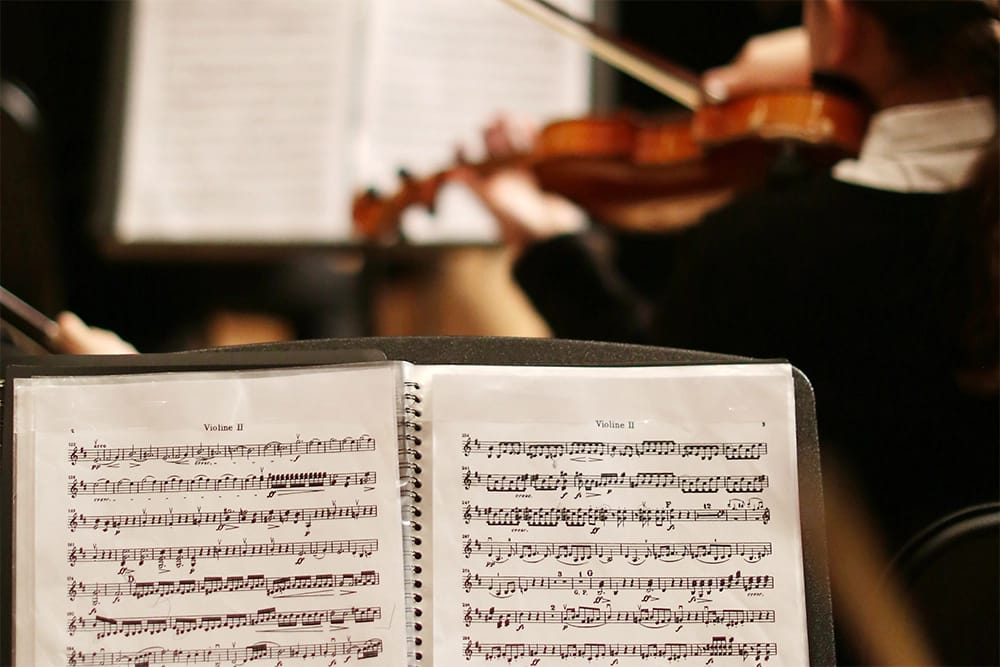 On an “A to Z” edition of The State of the Arts, a look at musical Notation… which, like any writing, allows one person to transmit an idea to another without having to meet in person. A composer today can, it’s true, make a recording, or even Skype into a rehearsal and let the players or conductor know how the performance should go… But the system of notation that’s developed since the middle ages means that composer should be able to send a score off knowing it will be performed more or less as intended.
On an “A to Z” edition of The State of the Arts, a look at musical Notation… which, like any writing, allows one person to transmit an idea to another without having to meet in person. A composer today can, it’s true, make a recording, or even Skype into a rehearsal and let the players or conductor know how the performance should go… But the system of notation that’s developed since the middle ages means that composer should be able to send a score off knowing it will be performed more or less as intended.
The standard of music notation that we use today is efficient – on a conductor’s score, each individual line corresponds to an instrument or section of the orchestra; reading from left to right, you’re moving forward in time… and at any point along the way, reading the page vertically will give a snapshot of the harmony being played.
 The standards of notation have been slowly refined over the years, although some of the principle ideas are very similar to the time of Gregorian Chants – when musical scores began to have an early “staff”, and the direction of melodies were determined by the placement of the noteheads. The shapes and groupings of the noteheads indicated their duration, and how the pitch would be approached – connected or detached from the note that came before, or with an ornamental melisma. But the text determined the rhythm and phrasing, and since they were sung in unison, dividing the melodies into measures wasn’t necessary.
The standards of notation have been slowly refined over the years, although some of the principle ideas are very similar to the time of Gregorian Chants – when musical scores began to have an early “staff”, and the direction of melodies were determined by the placement of the noteheads. The shapes and groupings of the noteheads indicated their duration, and how the pitch would be approached – connected or detached from the note that came before, or with an ornamental melisma. But the text determined the rhythm and phrasing, and since they were sung in unison, dividing the melodies into measures wasn’t necessary.
 Here’s an example of J.S. Bach’s handwritten manuscript, using notation that’s much more familiar to anyone who’s studied music. The staves are joined into a treble and bass grand staff, which is used for keyboard music, although this looks like one of the many Chorales that Bach wrote or reharmonized – which could be either played or sung. There are barlines separating the measures, and each of the four independent voices has a different rhythmic feeling. The melody in the soprano is slow and even, the bassline “walks” at a steady clip, and the tenor voice has ‘dotted’ rhythms of long notes followed by short ones, in almost a heartbeat dah – – dit, dah – – dit pattern.
Here’s an example of J.S. Bach’s handwritten manuscript, using notation that’s much more familiar to anyone who’s studied music. The staves are joined into a treble and bass grand staff, which is used for keyboard music, although this looks like one of the many Chorales that Bach wrote or reharmonized – which could be either played or sung. There are barlines separating the measures, and each of the four independent voices has a different rhythmic feeling. The melody in the soprano is slow and even, the bassline “walks” at a steady clip, and the tenor voice has ‘dotted’ rhythms of long notes followed by short ones, in almost a heartbeat dah – – dit, dah – – dit pattern.
 This single measure from Chopin’s Nocturne, Opus 2 No.1 trips off the fingers of a well-trained pianist, with a pattern of 22 notes meant to take the same amount of time as the 12 notes in the left hand. By not making the notes line up exactly, he creates a slightly relaxed and rhythmically free feeling (rather than one that tries to exactly work the math out precisely.)
This single measure from Chopin’s Nocturne, Opus 2 No.1 trips off the fingers of a well-trained pianist, with a pattern of 22 notes meant to take the same amount of time as the 12 notes in the left hand. By not making the notes line up exactly, he creates a slightly relaxed and rhythmically free feeling (rather than one that tries to exactly work the math out precisely.)
In Charles Ives’ Concord Sonata, he does away with the barlines altogether at times; the piece is fiendishly difficult (but fortunately, it’s only for one performer, and not an ensemble that has to stay together!)







